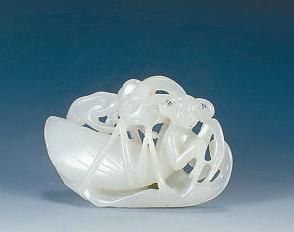Palace jade pieces in the Qing Dynasty

In recent years, during the Qing Dynasty, especially during the reign of the Qianlong Emperors, the Qing Dynasty palace jade pieces were very particular about the selection of materials. Whether Baiyu, Qingyu, Qingbaiyu, Jasper, Topaz, or Moyu, all Xinjiang and Daiyu were the best, and the texture was pure and meticulous. The darling of the field. In mid-December, a fine white jade carving “Sanyang Kaitai†of the Qing Dynasty's old jade collection will be unveiled at the Liuchao Art Fest. This ornament is made of the finest white jade seed material, which is white, flawless, and oily. Holding hands in the hand to admire, the heart sighed: "An Neng with white, and Mongolian dust?" The material shows its natural beauty. This piece of work is impeccably polished, and it does not have the reputation of “Baolonggongâ€. One or two or three goats were engraved using round carving technique. The goat was in a prone position. The middle goat and the back lamb both looked back. The big goat wore clouds, ribbons, and the mouth was fungus. The carving taiji pattern on the ganoderma was in front of the big goat. The lamb's mouth is Ganoderma lucidum grass, nestling beside the big sheep. Engraving can be described as silk thread, fine but not chaotic, the knife is the end of the knife in the end, combined with close, no cutting knife does not follow the phase. At the bottom of the mesoscopic view, smooth as a mirror and bright as glass, can be described as natural. The original red sandalwood base is carved with a sculpin technique to sculpt the ganoderma lucidum. It is noteworthy that there is a dragonfly disk between the rocks, the mouth ranks Ganoderma lucidum, the dragon's first face is like a beast, round nose, big nose, and cat's ear single angle. Tengyun away, vividly. Four feet below the base.
“Sanyang Kaitai†is also known as “Sanyang Kaitaiâ€, “Sheep†and “Yang†are homophones, and “Shuo Wen Jie Zi†says: “Sheep, Cheung Yeh.â€, “Sanyang Kaitai†and “Sanyang†"Kaitai" is auspicious. “Sanyang Kaitai†is said to come from the “Book of Changes,†and “Book of Changes,†said Qilian’s is Yangshuo, and the broken one is the Yinyin. The first month is the Thai Baht and Sanyang is born under the next; the winter comes in the spring and Yin Xiaoyang grows. There is the elephant of Jiheng. Commonly used to praise the first year or implied good luck. In the yin and yang theory, October is Kunyu. Pure yin like. In November, it was rejuvenated and a yang was born. December was Linyi, and Eryang was born below. The first month was the Thai baht, and Sanyang was born below. In the winter, when the spring goes to the yin to eliminate the sun, there is an elephant like Jiheng, which is called Sanyang Kaitai.
Ma Chi rate winds, sheep to clear and. This jade piece is the perfect unity of Qianlong imperial jade material and the superb craftsmanship of the palace craftsman. It also represents the image of Jiheng prosperous and prosperous and deserves special attention. The first auction of the Six Dynasties Arts Feast brought together more than a thousand pieces of fine arts such as Chinese painting and calligraphy, antique treasures, and jade zisha. From the solicitation of the auctions to the approval, the Jiangsu Liuchao Art Feast Auction Co., Ltd. has been very cautious and rigorous, not only because of the customer's trust in the Sixth Dynasty art banquet, but also because of the company's full confidence in the auction.
Cotton Dresses For Girls,Girls Dresses,Girls Cotton Dress,Girls Printed Viscose Dress
SHAOXING NEWTEX IMP.&EXP. CO., LTD , https://www.newtexgarment.com
